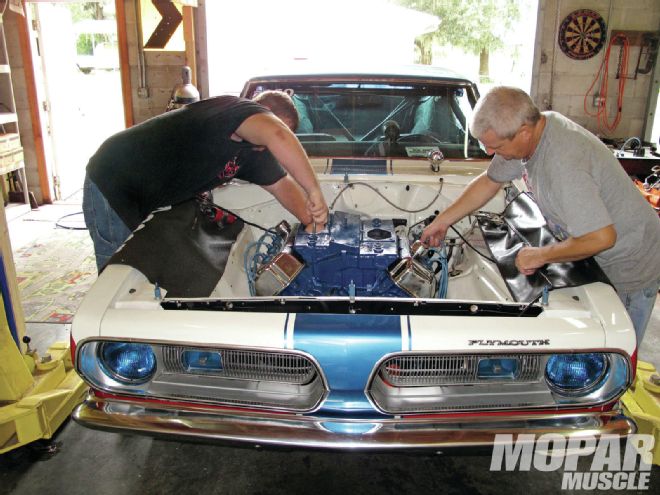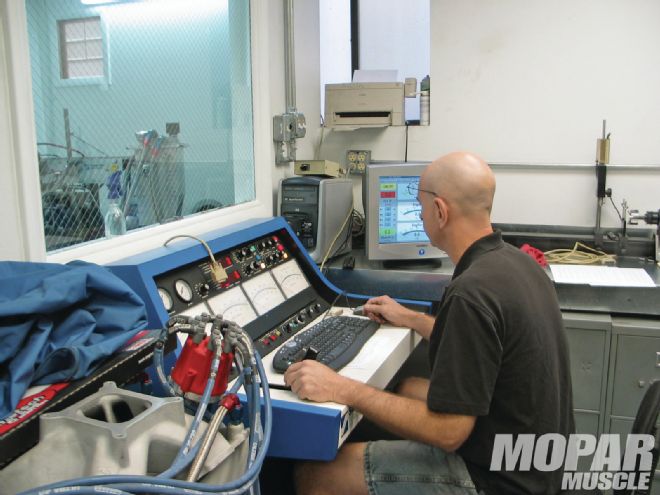
In the December issue of Mopar Muscle, we introduced this project, a 1968 Plymouth Barracuda Hemi car once raced by the legendary team of Sox and Martin, and described how honored we are to be working on such a historic piece of Mopar drag racing history. Owned by central Florida car collector and Mopar enthusiast Todd Werner, this Barracuda is one of the original BO29 coded Hemi A-Bodies assembled by Hurst, and was driven by Ronnie Sox during the 1974 racing season as the team honored Chrysler's request to boycott the Pro Stock class. Known as the "Protest Car", this Super Stock Barracuda was fitted with specially engineered suspension components at Chrysler's direction, and mechanics Dave Christie and Jake King assembled the car while Jake himself handled building the engine(s). And while the car is a beautifully restored piece, that Jake King Hemi had long been replaced by a tired, worn out street engine unworthy of such a noble home.
You'll remember from part one of this story that when we pulled the tired Hemi from this car and tore it down, we weren't left with much to rebuild. The block was cracked and would have required eight sleeves because the cylinder walls were so thin. The cylinder heads were cracked as well, both in the water jackets and between the valve seats and spark plug holes, so attempting to repair them for use in a performance build was out of the question. Even the crankshaft was trashed, already .030-inch undersized and with spun main bearings, so we had to scramble to find the appropriate parts to complete our engine. Fortunately, friend and Pro Toyz curator Chuck West found a factory block and heads that were buildable, and we got busy calling Summit Racing Equipment, Comp Cams, Indy Cylinder Head, and Milodon for the high-performance parts needed to build a stout Hemi for this Barracuda.
The first step was to define the use of the engine and devise a combination that will best achieve the desired goals. Since this car is part of a collection and will never be raced due to its historical significance, building a SS/AH class-legal Hemi just isn't be feasible. Aside from the expense and time that would be required to build a competitive Hemi, the class rules now are far different than they were in the sixties and seventies, allowing items like custom fabricated intake manifolds that just wouldn't appear correct on this car. An aftermarket block and heads weren't in the equation either, since there were no aftermarket blocks and heads available during the time when this car was raced. This Hemi needed to look period correct, but the owner wanted the engine to "cackle and pop" like a real race Hemi. Since we only know one way to make an engine sound like a race engine, we decided to take advantage of modern internal components and build a true, high-compression race Hemi for this Barracuda.
Using a factory 1968 block, we determined that our engine needed a crank, so we added a little stroke by installing a Scat 4.15-inch stroke crankshaft. Achieving high compression in a Hemi requires careful planning and can lead to several valve-train interference issues, so by adding stroke we effectively increased the compression of this engine, as well as the displacement, without putting the piston any closer to the valves than necessary. Using a set of lightweight Keith Black forged 12.5:1 pistons, we had Auto Performance Engines bore and hone the cylinders to the recommended .0055-inch piston to wall clearance, then mill the deck of the block to get the piston as high in the cylinder as possible. We then calculated the necessary combustion chamber volume and shaved the heads, achieving a true compression of just over 13.5:1. The tough factory connecting rods were inspected and resized, and we installed ARP rod bolts before balancing the entire rotating assembly for smooth operation.
Factory Hemi cylinder heads flow great without much work, but since there's always room for improvement we touched up the ports and bowls, then had APE perform a multi-angle valve job and install Manley stainless steel valves along with Comp PN 948-16 triple valve springs to match our custom solid roller camshaft, also from Comp. Our cam was ground with an LSA of 106 degrees, and features duration at .050-inch lift of 282 and 286 degrees, and a gross valve lift of .672-inch intake and .667-inch exhaust using Indy roller rockers with 1.6 and 1.55 ratio. While we would have increased the lift to around .800 inch if this were a competition engine, the increased valve lift just didn't make sense given the purpose of this build, and would only wear out parts like valve springs and guides.
Other than the reduced valve lift, we built this engine to the same specifications as we would any other race engine, checking and setting bearing clearances and measuring all the critical dimensions such as piston to head, piston to valve, valve to block, and retainer to guide clearance. We degreed the camshaft using Comp's PN 3125KT adjustable three-bolt timing set, and used Clevite bearings and Fel-Pro gaskets from Summit Racing Equipment. Milodon supplied the ¢ inch internal oil pickup, windage tray, and intermediate shaft with a bronze gear which is necessary with a billet roller camshaft. To Maintain a period correct look we're using the fabricated oil pan that came with the car, which appears very close to oil pans used during the seventies, and may be an original Sox and Martin piece.
Assembling a race engine takes time, as the engine is actually assembled several times during the process to check clearances. We also file fit the piston rings for this engine, using the piston manufacturers factor of .004-inch times the bore size. Remember that file fit rings use a multiple of the bore size for an end gap, so the dimension will be slightly different for each different bore size, which is why most manufacturers don't just recommend a specific gap measurement. With everything checked for a final time, we cleaned our parts with soapy water and began the procedure of assembling this 478-inch Hemi.
Once finished with the assembly, we painted the Hemi blue, which was a trademark of King, and fit the theme of this car nicely. With the engine ready to install, we enlisted the help of Garret Struck to give us a hand with the transplant. Not wanting to take ANY chances with this piece of history, a second pair of hands seemed like a good idea. As a historic race car, this Barracuda is equipped with a Lakewood bell-housing, large tube headers, and an already tight engine bay, it takes careful maneuvering to wedge a Hemi in these cars.
After our engine was installed, inspected, and the initial adjustments made, it was time to fire this beast up and hear the new Hemi, and we connected the battery, powered the car up, and bumped the starter. Click. Oops, the battery is dead. So while we waited for the battery to charge we again gave our work a final inspection, deeming the Hemi ready to fire. With a fully charged battery the starter was a little slow due to the compression of this engine, but the engine fired up on the first attempt and idled crisply with some 90 pounds of oil pressure.
We were both grinning from ear to ear as a crack of the throttle yielded immediate response, and the high-compression Hemi with open headers shook the car and rattled the garage like a race engine should. After setting the timing to 34 degrees total advance, we let the engine come to temperature and checked for leaks. We'd love to take this beast to the drag strip, but being installed in a historic car like this Barracuda will prevent us from seeing the engine's true potential at the track. Luckily, Todd regularly displays his cars at events, so we'll be able to hear the Hemi run whenever he brings it out. Hmmm. He doesn't pick the car up until tomorrow, Lakeland has a test-n-tune on Thursdays... No, better not even think about it!
The Pieces
PartPart NumberPrice
Scat forged crankshaft4-440-4150-6760-2374$1,200.00*
Keith Black forged pistonsIC898/KTD$600.00*
Comp roller camcustom grind$319.95*
Comp roller lifters829-16$386.95*
Comp timing set7125$126.95*
Comp valve springs948-16$355.95*
Manley intake valvessevere duty$115.95*
Manley exhaust valvessevere duty$115.95*
Milodon oil pickup18335$43.95*
Milodon windage tray32005$61.95*
Indy rockers, stands and pushrods426-R4-27SK$2,305.00*
Bearings gaskets and seals$525.00*
Machine work$2,300.00*
*These are the prices we got for the parts as of this writing. If they have changed, that's not our fault.
When it comes to projects around here, we love to test the parts we use in our technical articles whenever it makes sense. We're lucky to have access to an engine dynamometer locally, and our tech center in Tampa has a chassis dyno as well. Where we love to test, however, is at the track, because nothing gives bragging rights around the office like a low elapsed time in the quarter mile. There are some instances, however, when dyno or track testing just don't make sense, and this build is one of those cases.
There's no doubt we'd love to make a pass in this car, but there's really nothing to achieve by doing so. Since the car will not be raced competitively, it doesn't matter how quick it is, and the risk of something happening to the car outweighs any reward we may hope to achieve. The same goes for the engine dyno, as the expense just isn't worth it in this case. From experience, we know the approximate power this engine will make-close to 700 horsepower, being limited by the intake and low lift camshaft, and could make more had we not compromised in certain areas given the car's intended use. Additionally, the chassis dyno places a load on not just the engine, but drivetrain components and rear tires as well.
